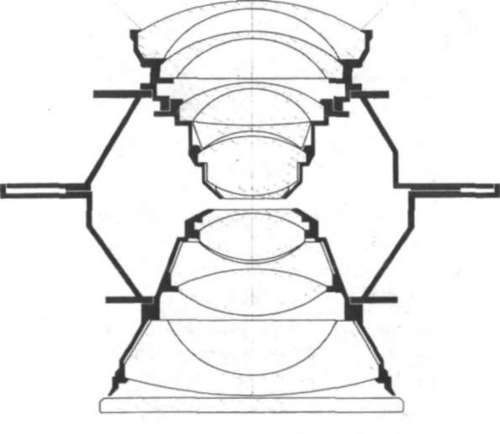Resolution Of The Image
Description
This section is from the book "Aerial Cameras, Aerial Films, And Film Processing", by Richard W. Underwood.
Resolution Of The Image
The quality of the lens is of major importance (figure 7). It should have a high factor of light transmission (that is, ability to permit all or nearly all the available light reflected from the subject to reach the film). It should be a fairly fast lens (that is, have the ability to transmit sufficient light to the film in a relatively short exposure time). Lenses of f/4.5 or f/5.6 are generally considered fast enough for most aerial applications. Basically, the f-number is a computation of the ratio of the calibrated focal length of the system to the diameter of the lens aperture. For example, an f/10 aperture would be about 10 mm for a 100-mm-focal-length lens. Several camera manufacturers are beginning to use T-numbers instead of f-numbers. The T-num-ber system additionally takes into consideration the transmission capabilities of the lens system.
The true distortion-free lens is not yet a reality. Optical distortions are the result of many factors which cause deflection of a light ray from its true and correct location on the film. For precise mapping, residual distortions of less than 0.01 mm are required. When information to be secured does not require such precision, lenses of greater radial and tangential distortions can be tolerated, and they usually have superior resolving power. The flatness of the focal plane can also affect the total optical ray distortion. The degree of perpendicularity of the focal plane to the optical axis is another factor which must be considered.

Figure 7. Modern aerial camera lenses are complicated and precise. Shown: the new 150-mm Universal-Aviogon II f/4 lens by Wild-Heerbrugg.
The above considerations all affect the ability of a camera to record a specific image. In addition, the optical precision of the lens elements plays a very important part in the ability of the lens to resolve a subject. In total, the resolution capability can be expressed as the system's ability to distinguish two distinct line pairs of a specified width, with equal spacing, at varying contrast levels. The resolution will vary in different parts of the lens (best at the center) and with different levels of contrast.
Generally, you should not consider lenses that demonstrate static resolutions below 40 line pairs per millimeter at a contrast ratio of 1:1000 on the optical axis of the lens. If you are solely interested in information and not geometric fidelity, lenses of 80 or more line pairs per millimeter should be considered.
Continue to:
- prev: Focal Length
- Table of Contents
- next: Spectral Responses
